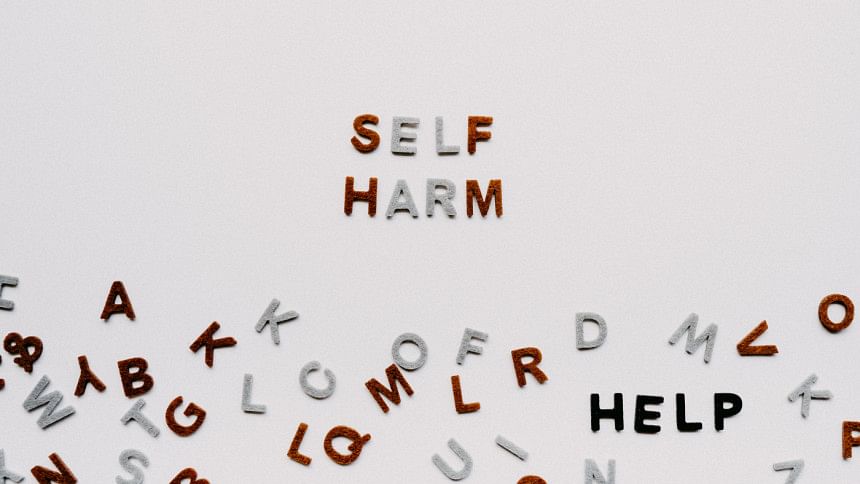Understanding self-harm: A cry for help, not attention

Self-harm is a complex and often misunderstood behaviour that refers to the act of deliberately hurting oneself, typically by cutting, burning, or hitting one's own body. Although it is often associated with adolescents and young adults, self-harm can also be observed in older people. Unfortunately, despite the prevalence of self-harm in almost every part of our society, it remains shrouded in stigma.
A topic as sensitive as this stirs up a million questions in all of us; questions that almost never get asked — Why do people engage in self-harm? Are they mentally unstable or dangerous? Are they suicidal?
An open discussion is not only the best, but also our only option if we want to find these answers.
In an interview with Star Lifestyle, Dr Helal Uddin Ahmed, Associate Professor, Child, Adolescent and Family Psychiatry at the National Institute of Mental Health (NIMH), lays out the reasons as well as common misconceptions about surrounding self-harm in our country.
"Self-harm is a way for individuals to manage intense emotional distress when they do not have the skills or resources to cope with it effectively," explains Dr Ahmed. "Anxiety, inner conflict, and trauma from some past events are some of the common reasons found in people engaging in self-harm."
It truly seems bizarre at first: coping with pain by causing more pain. At the very heart of the issue is a severe lack of healthy outlet for emotions. At some point in our lives, we are bound to find ourselves in extremely difficult situations that weigh heavy on our mental state. In the absence of proper ventilation of these emotions, they may build into something much worse making us feel like we are drowning and suffocating within ourselves.
According to Dr Ahmed, the physical pain creates endorphins; hormone that causes a momentary sense of relief from one's anxiety and/or PTSD. When done repeatedly, these self-harming acts become the only source of relief thereby making it difficult for one to stop.
The symptoms are subtle but with the right information, we can identify self-harming tendencies among a friend, family, or even ourselves.
While it is natural to be disappointed when we fail to accomplish something, the problem arises when we start seeing ourselves as failures in every sphere of life. This is in fact one of the earliest signs of self-harm. The constant urge to put yourself down and think negative can even lead you to withdraw yourself from friends and family. Once isolated, your anxiety can increase multi-fold.
As difficult as it may be, it is important to remember a close family member or friend can be your confidant in this situation. Sometimes, being able to share what's really bothering you can immediately put your mind at ease.
Many people engaging in self-harm may feel ashamed or embarrassed, leading them to hide their behaviour from loved ones and mental health professionals. However, seeking help is crucial in order to address the underlying psychological causes and prevent further harm.
Unexplained cuts, bruises, or burns are something we must not overlook in anyone we know. If you suspect that a loved one is engaging in self-harm, it is important to talk to them in a compassionate and non-judgmental way. Let them know that they are not alone and you will help them find better ways to cope with their emotions.
"It's very important to understand that self-harm is not a suicide attempt," says Dr Ahmed. "On the contrary, people engaging in self-harm are often desperately trying to escape from something much bigger. They choose to this as a source of survival. They want to live."
Dr Ahmed further explains how self-harm may be a manifestation of underlying personality traits or disorders. Individuals with borderline personality disorder may engage in self-harm as a way to regulate their emotions, while those with obsessive-compulsive disorder may do so as a way to reduce their anxiety.
Each form of self-harming pattern has a thread-like difference from another and only experienced therapists and counsellors can help effectively bring someone out of this state.
It is unfortunate that even at this age and time, where mental health awareness is more prevalent than ever before, something as critical as self-harm is still met with silence and shame. Change does not come in a day, but we must start somewhere if we wish for no one to suffer in silence anymore.
Our small steps to create a safe and supportive environment can go a long way. We can encourage them to seek help without any hesitation, engage in activities they enjoy, spend time with loved ones, and prioritise self-care activities such as exercise, sleep, and healthy eating. Ultimately, self-harm is a complex and deeply personal behaviour that requires understanding and support.
With patience, empathy, and professional help, individuals who engage in self-harm can find a path towards healing and recovery.

 For all latest news, follow The Daily Star's Google News channel.
For all latest news, follow The Daily Star's Google News channel. 








Comments